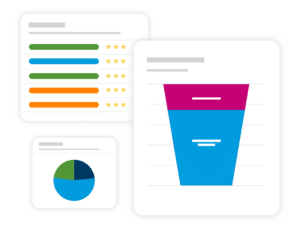3 Strategies for Improving CX
Consumers today have a wealth of options; this puts immense pressure on organizations to ensure they deliver a consistently great customer experience to ultimately build long-term and profitable customer relationships.
But studies show that brands are falling on the job. According to figures from PwC, 59% of global consumers feel that companies have lost touch with the human element of customer experience (CX). In contrast, global SugarCRM research found that 58% of companies say their customer churn has increased in the last 12 months.
While the pandemic has introduced new customer experience trends and reminded us of the value of relationships, we are increasingly seeing businesses prioritizing service-driven over sales-driven agendas. Now is the time to get ahead of your competitors on the customer experience front and provide a first-class customer journey.

Here are three essential strategies for improving your customers’ experience:
1. Using AI to Create Empathy in Marketing Strategies
With the pandemic shifting buying behavior to online channels, the demand for rewarding and streamlined experiences online is critical. Empathy and personalization are key to performing here—all now easily in our grasp thanks to technological advances.
Marketers are now juggling mass amounts of customer data to interpret and make personalized, empathic communications, something too laborious and time-consuming a task for humans to complete. We want to give that local corner shop experience, but it’s impossible to scale up.
According to Gartner, “63% of digital marketing leaders still struggle with personalization. But only “17% use AI and machine learning across the function.” Until recently, many believed AI was solely used for assumptions and predictions. In reality, AI now has multiple uses and is not limited to just administrative and data-driven tasks. And it is only getting better.
With new tools and technology for automated sentiment analysis, AI is now replacing conventional feedback surveys with understanding customer sentiment and responding in real-time, focusing on prioritizing human emotions. AI can sort through voluminous data sets and help identify the next-best actions and opportunities to connect with customers and take their journey one step further. Using a combination of Natural Language Processing (NLP) and AI, each customer’s emotional state can be analyzed and passed on to the appropriate support. Ensuring that empathy is at the forefront of marketing strategy leads to an increase in new customer generation and trust amongst existing customers.

2. Embracing a Data-Driven Strategy
Gone are the days when marketers could work solely on experience and intuition. Becoming a data-driven marketer is the way forward to creating experiences tailored to each customer. Analytics can create detailed and accurate customer profiles that can help understand customer behavior and preferences to produce predictive insights to anticipate their actions and identify real-time solutions and opportunities.
Clear insights into customer behaviors, needs, and contextual data are crucial. However, Sugar research has revealed that up to 50% of sales leaders admit they cannot access customer data across marketing, sales, and service systems, leaving customer-facing team members without a clear picture of their customers.
This can be achieved by integrating a CRM platform that focuses on marketing automation and data collection. Data captured must include all touchpoints and key activity, such as calls, messages, emails, inquiries, competitor mentions, website interactions, and activity logging. This captured data should be logged automatically and linked to the lead, opportunity, or customer account.
A refined CRM platform will also have data collection techniques to help fill in the blind spots and ultimately help organizations make accurate predictions about future campaign efforts. This process involves various teams, including sales, marketing, customer success, customer service, and professional services. A common platform will easily link data captured across teams and support an integrated revenue management approach.
3. Creating a Holistic Customer Journey
Digital customer journeys nowadays are complex and continually evolving. There isn’t a straightforward “one size fits all” route to follow, and there’s often only one shot at making a lasting impression. Maintaining customer retention is more sensitive (and difficult) than ever. According to PwC, one in three customers say they will walk away from a brand they love after just one bad experience.
Companies that focus on improving customer experiences across a holistic customer journey are more likely to succeed and retain customers. This needs to be underpinned by flawless customer support. To achieve this, your frontline support agents must have the right technology, resources, and knowledge to diagnose and solve problems quickly.
A service-driven agenda that delivers a consistently personal customer journey both online and in-person will be the difference between long-term customer loyalty and losing these customers to the competition. Technology and data must be part of that process as they are integral to any modern sales and revenue management playbook. Analytics and advanced techniques such as AI can facilitate and contribute to forging memorable relationships with customers. Intelligent technology helps teams understand what a “good” customer experience looks like and subsequently allows sales processes to become repeatable.
Businesses should ask themselves: How do we optimize leads and ensure we provide the best possible experience for our customers across all their customer journeys.
This blog post is based on an article that was initially published on MyCustomer.


